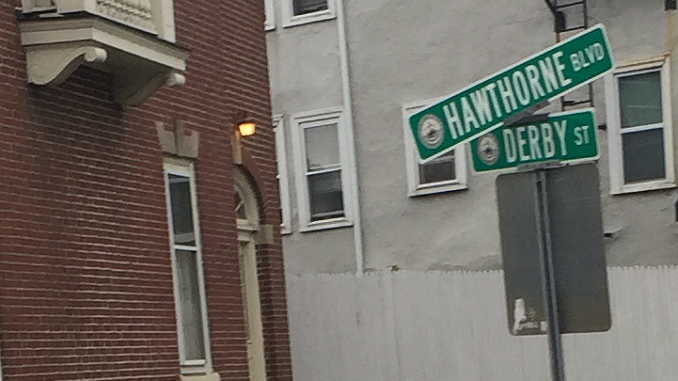
Salem’s long and diverse history could be seen in a variety of ways during our trip to Salem. Witch references could be seen on lampposts and were used in shop and restaurant names. In many ways, this part of Salem felt like a tourist trap. Maritime history could be seen at the Peabody Essex Museum, and was especially prevalent at the waterfront. While the waterfront of Salem was still touristy, it retained a larger sense of authenticity than central Salem did. Personally, all the past and present themes of Salem became clear and blended together when taking the trolley tour of Salem.
The trolley tour of Salem took us through the different neighborhoods of Salem, and as a result the different time periods and history of Salem. The trolley tour started by the Peabody Essex Museum, one of the areas I personally found to be more touristy. There were tourist shops galore, advertising “witch walks,” “psychic faires,” and “fine wizard wares.” Restaurants as well seemed to play up the tourist vibe given off by central Salem; they too had witch, wizard, and magic references. I found all of these witch references to be over the top. It seemed too planned and targeted, more like a section in a Disney Park than a real city.
However, just a few blocks away, the dark (now turned lively) witch history of Salem gives way to the more authentic maritime past. Though the port and wharfs are no longer bustling, it is easy to see how they once were. Furthermore, the maritime sector of Salem has not been as exploited as its witch history, in part it seemed to me because it is still relevant. There are many good seafood restaurants in and around Salem, and as a result the maritime/ sailing industry still exists (though to a much lesser extent than it once did). Walking around the coastline, it was much easier to envision Salem’s past than it was in the center of Salem. As it was less of a tourist spot, the coast retained more original features and houses. For me, seeing some of the original buildings as they were, and not surrounded by or turned into tourist spots, made it possible to envision historical Salem as it was in Charles Copeland’s story, “To the Farthest Port of the Rich East.” Seeing the houses some of the wealthy merchants were able to build, and hearing that the first millionaire in the United states lived in Salem truly brought its rich history to life.
Further on the tour, we reached a spot where all major periods of Salem’s past combined. This spot had been the site of witch hangings, a school for boys, a coast guard base, and a recreational spot. I felt that this one spot represented all of Salem. Salem became infamous for its witch hangings in the late 1600’s. The coast guard base is reminiscent of the maritime past, and partly the present. The school for boys and the recreational facility show a brighter side of Salem’s history; education and the ability to enjoy life. The recreational area of this site is the most inclusive of all of Salem’s past. One of the campgrounds here, 21, was the site of the last witch hanging. Just down the hill is the coast guard base, and now it has been transformed into the modern campground. This shows all of Salem’s best, and most famous (or infamous) periods of time in one concise area, allowing me to fully understand and visualize the diversity of Salem’s past.
Salem is a truly diverse city with a unique history. I found that connections between the various different eras; witches, wealthy merchants with a busy shipyard, and modern; were best shown and understandable during the trolley tour. I could really see the transitions between the tourist witchy area in central Salem, and the still somewhat touristy but more authentic coastal areas. Specifically, the site of the coast guard base, witch hanging location, and campground is the most intriguing for me, as it has been an integral to all of Salem’s history. Personally, I thought that this site blended the eras most efficiently and clearly. This made it easy to understand Salem’s diverse past, and how Salem grew into the city we can see today.
